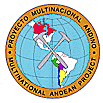 |
|
 |
The Multinational Andean Project:
A joint funded project with Canadian International Development Agency, the Geological Survey of Canada and the National Geoscience Agencies of Argentina, Bolivia, Chile & Peru.
Chile
INTRODUCTION
WORK AREAS
ADVANCE WORK IN COPIAPO ZONAWEB PAGE (http://www.sernageomin.cl/)
CHILE SPECIFIC OBJECTIVES
1º To generate high quality basic geological information in the economical depressed border Areas.
2º To generate detailed basic information about zones of hydrothermal alterations or mineralized occurrences, to understand the processes that generate them. This requires the application of model o Know deposit or establishing of new deposit models. These models will be utilized in more extensive exploration programs in the Central Andes.
3º Evaluate the water resources available within the study area. Mining activity requires water for various purposes. Precise information about the availability of water resources is essential in the desert area selected for the present study.
4º Widely distribute and transmit the results, to provide Private and State companies, with information that may stimulate mineral exploration in the region, and increase the probability of exploration success in the study areas; with consequent economic and social development for the region.
5º To reaffirm and increase scientific and technologic integration with neighbouring countries through the exchange of scientific knowledge, experience and information of volcanic systems and epithermal deposit, analytical support, joint field work (visits and workshops), joint meetings organization, etc.
6º Training and upgrading of skills for SERGEANOMIN young professionals in volcanology, geochemistry, hydrothermal alteration, structural geology, hydrogeology, etc. through attendance to seminars, congress, specialized courses, and postgraduate studies.
7º Improvements in the existing capacity of SERGEANOMIN in laboratory analysis (geochronology, and thin sections production and use), remote sensing, GIS, and application of computer equipment.
To accomplish both internal and integrationist objectives, within Chilean territory, we have established two work areas:
CH-1 Arica Altiplano between 17º 30' S and 20º 00' S, corresponding to an area of 280 km long and having maximum width of 100 km. In this sector, the Andean volcanic chain continues to the north toward Peru and the east into Bolivia.
CH-2 High Cordillera of Copiago, between 26º 30' S and 27º 30' S, corresponding to an area of 110 km in length and 70-km maximum width. It is to the east of Faja de Maricunga, a volcanic belt of the lower Ologicene Miocene age that has many epithermal gold and silver deposits. In this sector the volcanic belt extends toward Argentina both to the south and the oblique trend across the mountains of the political boundary.
Each sector will have an independent work program with the specific objectives being modified according to the geologic characteristics, the level of regional geologic knowledge, the social economic characteristics of the region, and the integration objectives of each region.
- Photogeologic interpretation for maps at scale 1:250.000 of the area proposed portions, based on satellite images (LANDSAT TM) and preliminary field reconnaissance.
- Preliminary geochemical and geochronologic sampling and determination of approximately 40 K-Ar radiometric ages and about 50 chemical analyses of major and trace elements as part of an FONDECYT project jointly with the Universities of Jujuy Argentina, and Cornell, USA.
- Work meeting with the Argentinean Geological Service Professionals in Mendoza, Dec. 1995, where we made, a work plan that is developing now, for the joint work in the Copiapo zona.
- Identifications of Argentina involve Area in the Project, with the FONDECYT project support with the Universities of Jujuy, Argentina, and Cornell, USA.
- Mapping to scale 1:50.000 of 1/3rd of the area involve in the Project, identification of the hydrothermal alteration zones illustrative sampling of superficial water.
- Petrographic studies, geochemical analysis, radiometric dates in process, processing of results and preliminary maps' elaboration.